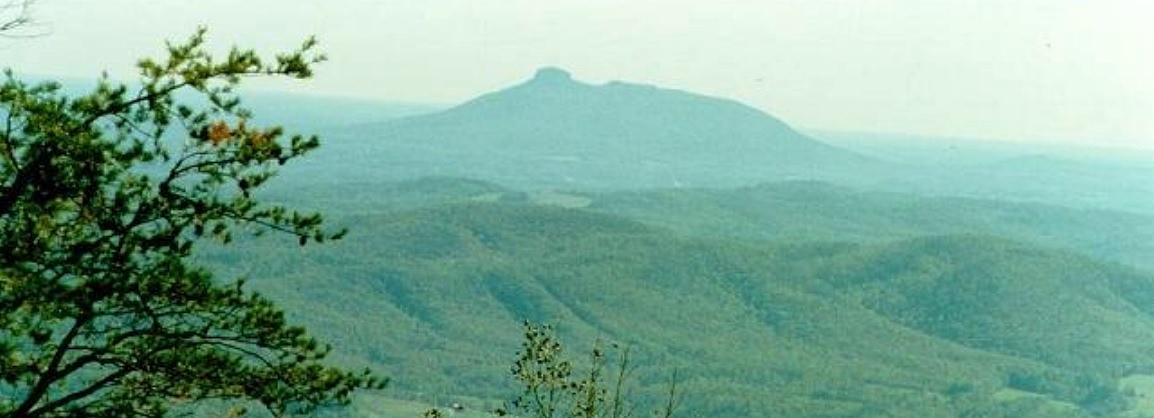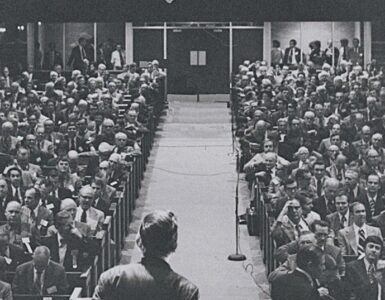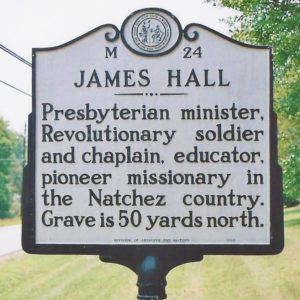 James was born August 22, 1744 in York County, Pennsylvania, the third son of his like-named father and judicious mother, Prudence (Roddy) Hall. His parents left Pennsylvania with their nine children heading west, then down the Shenandoah Valley settling in the Fourth Creek area of Rowan County, North Carolina. The area includes what is currently Statesville in what is now Iredell County. The Halls were Presbyterians and had been founding members of the Conewego Church in Pennsylvania. The western part of the state was decidedly Presbyterian with Scots-Irish enjoying freedom to worship according to the Bible and the Westminster Standards while farming and raising livestock on the gently rolling iron-rich hills. The Halls joined others in founding Bethany Church in 1775.
James was born August 22, 1744 in York County, Pennsylvania, the third son of his like-named father and judicious mother, Prudence (Roddy) Hall. His parents left Pennsylvania with their nine children heading west, then down the Shenandoah Valley settling in the Fourth Creek area of Rowan County, North Carolina. The area includes what is currently Statesville in what is now Iredell County. The Halls were Presbyterians and had been founding members of the Conewego Church in Pennsylvania. The western part of the state was decidedly Presbyterian with Scots-Irish enjoying freedom to worship according to the Bible and the Westminster Standards while farming and raising livestock on the gently rolling iron-rich hills. The Halls joined others in founding Bethany Church in 1775.
James’s early education included reading the Bible and studying the catechisms composed by the Westminster Assembly. He prepared for college at Crowfield Classical Academy which is said by some historians to be the seed for Davidson College. Crowfield could be considered the Log College, if it was log, that led to the founding of Davidson. It was not until James was twenty that he professed faith in Christ and then later purposed to become a minister, but his plans were delayed because he was unable to get the education he needed due to health and financial reasons. Eventually, he mastered preparatory lessons and traveled to Princeton to study for the ministry at the College of New Jersey during the presidency of John Witherspoon. Mathematics fascinated him and science increasingly grabbed his time and attention, but his sessions in theology with Witherspoon impressed him the most. Half-way through his college experience, James joined the Cliosophic Society and assumed the name Owen in honor of Owen Glendower who led the unsuccessful and last major attempt to overthrow English rule of Wales. One might expect James to choose a Scots or Irish name given his ancestry, but Scotland, Ireland, and Wales enjoyed a common bond in their resentment of English rule. James did well and was even considered to teach mathematics at Princeton but upon graduation in 1774 he returned to North Carolina to be a minister.
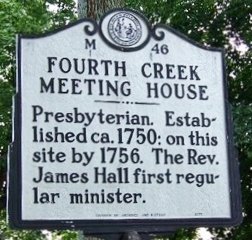 Like Joseph Caldwell and Andrew Flinn, Hall became a member of Orange Presbytery. Following a two-year period testing his gifts under licensure, he was ordained April 8, 1778, for a call that included three congregations—Fourth Creek (currently First Church) in Statesville, and nearby Concord and Bethany. The Revolution was taking place and Hall became a chaplain and captain for the Volunteer Cavalry of North Carolina, 1778-1782. His grave in Bethany Church cemetery has a separate memorial added at some point in the years following his death testifying to his service. In 1790 he was dismissed from Fourth Creek and Concord to pastor Bethany Church alone.
Like Joseph Caldwell and Andrew Flinn, Hall became a member of Orange Presbytery. Following a two-year period testing his gifts under licensure, he was ordained April 8, 1778, for a call that included three congregations—Fourth Creek (currently First Church) in Statesville, and nearby Concord and Bethany. The Revolution was taking place and Hall became a chaplain and captain for the Volunteer Cavalry of North Carolina, 1778-1782. His grave in Bethany Church cemetery has a separate memorial added at some point in the years following his death testifying to his service. In 1790 he was dismissed from Fourth Creek and Concord to pastor Bethany Church alone.
Ministers were few and far between and isolated settlements of Presbyterians needed pastoral care and leadership in worship. Presbyteries often appointed ministers on a rotating basis to supply preaching for remote congregations and in other cases they led worship at preaching points where people often came from considerable distances to worship (sometimes they met in fruit arbors for shade). The supply system provided ministers to remote locations sometimes as infrequently as once a month. James Hall was a dedicated supply to remote congregations. On one occasion he reported to the Synod of the Carolinas that he traveled 1132 miles, preached forty times, and was compensated financially with 64.68. Even though the judicatories described their preacher supply system as missionary work, the pastoral supply system was intended more to sustain existing congregations than begin new churches. Hall himself commented that “it would be more advisable to cherish our own societies, than to attempt to establish new societies.” He continued missionary journeys until late in 1818 when he was seventy-four years of age.
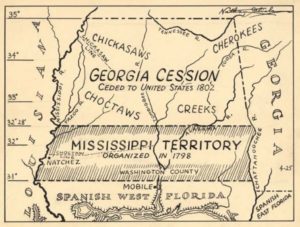 The longest and most challenging missionary trip for Hall was assigned to him by the Presbyterian General Assembly. In 1800 Hall, along with James H. Bowman and William Montgomery, traveled west to Natchez in the Mississippi Territory. At the time, the Mississippi Territory included the area that is currently the southern portions of the states of Alabama and Mississippi. After an expedition of a little over four months the trio returned to their respective ministries. In 1801 Hall published a one-thousand copy edition of his journal titled, A Brief History of the Mississippi Territory, one of which he gave to recently inaugurated President Thomas Jefferson. In a letter accompanying the book, December 5, 1801, Hall told the president that the book
The longest and most challenging missionary trip for Hall was assigned to him by the Presbyterian General Assembly. In 1800 Hall, along with James H. Bowman and William Montgomery, traveled west to Natchez in the Mississippi Territory. At the time, the Mississippi Territory included the area that is currently the southern portions of the states of Alabama and Mississippi. After an expedition of a little over four months the trio returned to their respective ministries. In 1801 Hall published a one-thousand copy edition of his journal titled, A Brief History of the Mississippi Territory, one of which he gave to recently inaugurated President Thomas Jefferson. In a letter accompanying the book, December 5, 1801, Hall told the president that the book
is not sent for any supposed degree of merit which it displays; but as my worthy friend, the Comptroller of the United States, informed me that the history of the territory is but little known, even at the seat of government, I flatter myself that the transient view given in the work may afford to your Excellency some gratification.
The President of the Republic might not have cared for being called “your Excellency,” but the content of Hall’s book may have contributed to influencing Jefferson’s decision to organize the Lewis and Clark Expedition to survey the Louisiana Purchase in 1804. But the main purpose of the Mississippi trip was to determine opportunities for ministry by the Presbyterian Church. Hall’s report was delivered to the General Assembly in 1803 and it informed the presbyters that the territory was short of teachers and had but four Presbyterian ministers. In the Carolinas there was a shortage of ministers, but the remote and rugged Mississippi Territory had nearly none. The General Assembly organized a few mission trips, but its work would be limited into the second decade of the century. In some cases synods including Hall’s Synod of the Carolinas sent missionaries to the expanding frontier on their own. Hall was an indomitable traveler who made additional trips for ministry until his last journey at the age of sixty-eight which included 1485 miles of travel and 58 sermons over a period of four months. It was all done on the back of a horse or possibly in a wagon aided by boats when waterways were available; the speedy travel offered by railroads was yet to come.
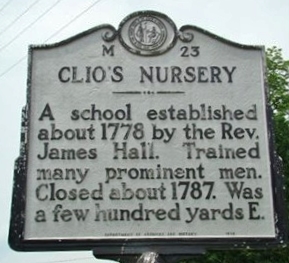 James Hall was the minister of Bethany Church, a well-traveled missionary, a historian and scientist, but that is not all—he was interested in advancing preparatory, college, and seminary education. As a matter of fact, it seems that any time he could find someone who wanted to learn, no matter the subject, he taught. Educational work began in his home where he operated an academy of the sciences for young men who could not afford to go to college. He started Clio’s Nursery which was set upon a hill high enough to provide students views of Pilot Mountain to the east and the Appalachians to the west. Note that in the eighteenth century a common definition of nursery was a place where people received training, but today it is a baby’s room or the church care ministry for wee ones that often suffers from a shortage of volunteers. Clio’s Nursery existed for about ten years beginning in 1778 and even though Hall founded it, the classes were taught by other masters. Hall also tutored men for the ministry such as Andrew Flinn, mentioned earlier in this biography, and the founder of Hanover College in Indiana, James Blythe. Another school owing its beginning to Hall was chartered at Bethany Church in 1822 as Ebenezer Academy. The school was operated by some of Hall’s nephews until it closed in 1856 but then reopened after the Civil War as a private school. Pastor Hall even saw the need to “promote useful knowledge in his congregation” so “he formed a grammar class which met every Saturday.” Books were scarce and expensive, so he provided handwritten copies of his own grammar and distributed it to his students. Currently, the opportunity for an education is available through public and private schools, but in the early New Republic, classroom teaching was often scarce. A library was gathered by Hall for local use and he encouraged debating societies among the young people. He was an active promoter of education in North Carolina well beyond his Iredell County home. In 1777 he became a trustee of Liberty Hall Academy in Charlotte and when it was moved to Salisbury to become Salisbury Academy in 1784, he continued on the board. The University of North Carolina benefited from his educational interests because he contributed both money and books and was a member of its philanthropic society. It is significant that he served as a director of the recently established Princeton Theological Seminary from 1815 to 1820 and helped with the challenge of raising funds in the early years. Hall was honored with the Doctor of Divinity by Princeton University, 1803, and then another honorary degree was presented by the University of North Carolina during graduation of the class of 1810 which included among its men a future Presbyterian General Assembly moderator, John Witherspoon (1791-1853).
James Hall was the minister of Bethany Church, a well-traveled missionary, a historian and scientist, but that is not all—he was interested in advancing preparatory, college, and seminary education. As a matter of fact, it seems that any time he could find someone who wanted to learn, no matter the subject, he taught. Educational work began in his home where he operated an academy of the sciences for young men who could not afford to go to college. He started Clio’s Nursery which was set upon a hill high enough to provide students views of Pilot Mountain to the east and the Appalachians to the west. Note that in the eighteenth century a common definition of nursery was a place where people received training, but today it is a baby’s room or the church care ministry for wee ones that often suffers from a shortage of volunteers. Clio’s Nursery existed for about ten years beginning in 1778 and even though Hall founded it, the classes were taught by other masters. Hall also tutored men for the ministry such as Andrew Flinn, mentioned earlier in this biography, and the founder of Hanover College in Indiana, James Blythe. Another school owing its beginning to Hall was chartered at Bethany Church in 1822 as Ebenezer Academy. The school was operated by some of Hall’s nephews until it closed in 1856 but then reopened after the Civil War as a private school. Pastor Hall even saw the need to “promote useful knowledge in his congregation” so “he formed a grammar class which met every Saturday.” Books were scarce and expensive, so he provided handwritten copies of his own grammar and distributed it to his students. Currently, the opportunity for an education is available through public and private schools, but in the early New Republic, classroom teaching was often scarce. A library was gathered by Hall for local use and he encouraged debating societies among the young people. He was an active promoter of education in North Carolina well beyond his Iredell County home. In 1777 he became a trustee of Liberty Hall Academy in Charlotte and when it was moved to Salisbury to become Salisbury Academy in 1784, he continued on the board. The University of North Carolina benefited from his educational interests because he contributed both money and books and was a member of its philanthropic society. It is significant that he served as a director of the recently established Princeton Theological Seminary from 1815 to 1820 and helped with the challenge of raising funds in the early years. Hall was honored with the Doctor of Divinity by Princeton University, 1803, and then another honorary degree was presented by the University of North Carolina during graduation of the class of 1810 which included among its men a future Presbyterian General Assembly moderator, John Witherspoon (1791-1853).
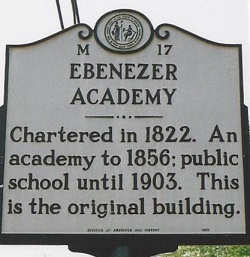 Even though it seems at this point that James Hall was stretched about as far as anyone could be, he still managed to be a good pastor who was loved by his congregation and fellow presbyters. He visited the sick of not only Bethany Church but also those he heard about from local physicians. Just as he had been brought up on the Westminster Standards, he catechized not just the children but also adults, even elderly ones. With regard to his extended, connectional church work, Hall moderated the last meeting of the Synod of the Carolinas in 1812 before North Carolina was set-off in its own synod. Hall commented to a friend in a letter in 1816 that he was attending the General Assembly for the eleventh time. During one of the Assemblies, 1803, Hall served at the podium as the moderator. In later years he was appointed the president of the North Carolina branch of the American Bible Society.
Even though it seems at this point that James Hall was stretched about as far as anyone could be, he still managed to be a good pastor who was loved by his congregation and fellow presbyters. He visited the sick of not only Bethany Church but also those he heard about from local physicians. Just as he had been brought up on the Westminster Standards, he catechized not just the children but also adults, even elderly ones. With regard to his extended, connectional church work, Hall moderated the last meeting of the Synod of the Carolinas in 1812 before North Carolina was set-off in its own synod. Hall commented to a friend in a letter in 1816 that he was attending the General Assembly for the eleventh time. During one of the Assemblies, 1803, Hall served at the podium as the moderator. In later years he was appointed the president of the North Carolina branch of the American Bible Society.
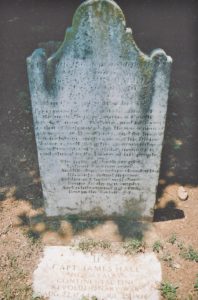 James Hall preached his last sermon in 1819 and died at Bethany Church July 25, 1826 after an extended period of declining health. He is buried at Bethany Church. James Hall never married. He did not write much but added to the report of his Mississippi Territory trip is an interesting little book titled, A Narrative of a Most Extraordinary Work of Religion in North Carolina, which tells of mass revivals in North Carolina and another in South Carolina in the spring and summer of 1802. Just the previous summer the massive Cane Ridge revival occurred in Kentucky and Hall’s experiences and observations are similar to Cane Ridge with people screaming out, lying down as though dead, and other manifestation attributed by Hall to the work of God as the individuals came to religion. However, in Hall’s case, the manifestations he saw did not go to the extent of those at Cane Ridge. Hall and Samuel McCorkle corresponded about revivals and some of McCorkle’s letters are in A Narrative.
James Hall preached his last sermon in 1819 and died at Bethany Church July 25, 1826 after an extended period of declining health. He is buried at Bethany Church. James Hall never married. He did not write much but added to the report of his Mississippi Territory trip is an interesting little book titled, A Narrative of a Most Extraordinary Work of Religion in North Carolina, which tells of mass revivals in North Carolina and another in South Carolina in the spring and summer of 1802. Just the previous summer the massive Cane Ridge revival occurred in Kentucky and Hall’s experiences and observations are similar to Cane Ridge with people screaming out, lying down as though dead, and other manifestation attributed by Hall to the work of God as the individuals came to religion. However, in Hall’s case, the manifestations he saw did not go to the extent of those at Cane Ridge. Hall and Samuel McCorkle corresponded about revivals and some of McCorkle’s letters are in A Narrative.
Barry Waugh
Notes—The header image is from Wikimedia Commons and it shows Pilot Mountain from a look-over in Virginia; it may seem a stretch to be able to view the mountain from Statesville, but given its height and the elevation of Clio’s Nursery, the roughly sixty miles fits within the curvature of the earth. GitHub offers a line of sight curvature of the earth calculator. The map of the Mississippi Territory is from Wikimedia Commons. The other pictures were taken by the author. Quotes about his educational work and other information are from Centennial Addresses on the Life and Character of Rev. James Hall, D.D., and Short Sketches of the Ministers of the Gospel who have Descended from James and Prudence Hall. Covington: Tipton Record Power Presses, 1885 [possibly 1875]. The quote by Hall about sustaining congregations in missions work is from W. Frank Craven’s biography in Princetonians, 1769-1775: A Biographical Dictionary, 1980. Hall’s letter to Thomas Jefferson along with some helpful commentary is available on the National Archives site under the title, “To Thomas Jefferson from James Hall, 5 December 1801.” The volume of W. B. Sprague’s Annals of the American Pulpit was also a source. Information about Hall which is primarily about his Revolutionary War service is in a Presbyterian publication titled, Centennial Addresses, Synod of North Carolina, Delivered at Alamance Church, Greensboro, N.C., October 7, 1913; one would have hoped a church publication could have said more about him as a minister. Another source for Hall and his ancestors is, History of Old Fourth Creek Meeting House 1764-1939 now the First Presbyterian Church of Statesville, North Carolina. The Mississippi Territory changed in size over the period of its existence. The Mississippi Department of Archives and History says that—”April 7, 1798, Congress created the Mississippi Territory. The territory’s original boundaries consisted of the region bounded by the Mississippi and Chattahoochee rivers in the west and east, the 31st parallel in the south, and the point where the Yazoo River emptied into the Mississippi River in the north. The territory expanded twice over the next two decades. In 1804, the northern boundary was extended to the Tennessee state line, and in 1812, President James Madison annexed additional land along the Gulf of Mexico Coast. By 1813, the Mississippi Territory encompassed the boundaries of present-day Alabama and Mississippi.”


